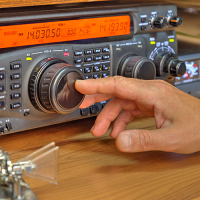Winter Fishing is more than it gets credit for
By Eugene Shuler
Winter is a great time to go fishing. Don’t believe me? Just look at what you don’t see this time of year, and that’s other people on the water fishing your favorite spot.
While it’s true that fish don’t bite quite as well as they did in the summer months, they still have to eat. Knowing a few key factors and which flies to use will make all the difference between a successful day and one where you should have stayed home and watched the Winter Olympics.
The most important factor to consider when winter fishing is the water temperature. Thermometers such as the ones used for checking food temperatures are great for checking stream temperatures. Check the water you are fishing periodically, and look for temperatures that rise or stay the same.
Rising water temperatures will cause the fish to start feeding almost as good as warmer months. If the temperature of the water drops, pack up and go home to watch the Olympics. The fishing will surely become worse. Also, look for areas where sunlight is on the water for an extended period of time. These types of places tend to be warmer and will yield some great fishing.
Presentation is also an important key in winter fishing. The fish tend to be slower and will not travel as far to eat a fly. The best presentations are slow and accurate. Fish an area of water slower than normal and make sure to cover the entire section before moving on. If you spot a fish, make sure to place your fly accurately in front of it. Trout will not move very far at all to chase an ill placed fly in cold weather.
Related Items
Fishing on the Tuckasegee and Nantahala rivers is very good with trout in the 20-inch range being caught daily. Most fish tend to be holding at the tails of the pools and runs, and big rainbows have been caught in the faster sections of water. Watch for the water to rise on the Tuck usually around noon; check generation schedules before heading out. In the Great Smoky Mountains National Park, the brown and brook trout have just about stopped spawning, but good-sized fish can still be seen on gravel flats and will hit almost anything that drifts by them.
Flies for this time of year tend to be smaller in size than in other months. Suggested Dry Fly patterns are Grey Caddis #16-18, Little Winter Stone Fly #20-22, Blue Wing Olives #14-20, Parachute Adams #12-16, Thunderhead #12-16, Griffiths Gnat #18-22, and Tan Caddis #16.
Suggested Nymph and Streamer patterns are Bead Head Pheasant Tail #18, Secret Weapon #14, Bead Head Prince Nymph #16-20, Tan or Brown Caddis Pupae #16, Bead Head Hare’s Ear #14-20, Red or Green Copper Johns in #12-16, Red, Green, or Blue Brassie #16-20, Black or Brown Zebra Midge #18-22, Egg Pattern #12-14, Grey Soft Hackle #14-16, Pink San Juan Worm #12-14, Black, Brown, and Olive Wooly Buggers #6-10, and Muddler Minnow #8-10.
For some great fly fishing information visit an on-line fly-fishing chat site at southernflyfishersforum.com.
(Eugene Shuler is co-owner and guide of Smoky Mountain Fly Fishing, which leads trips throughout the region and has offices in Bryson City and Cherokee.)









